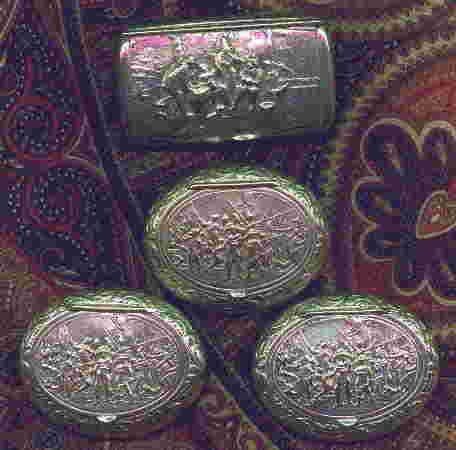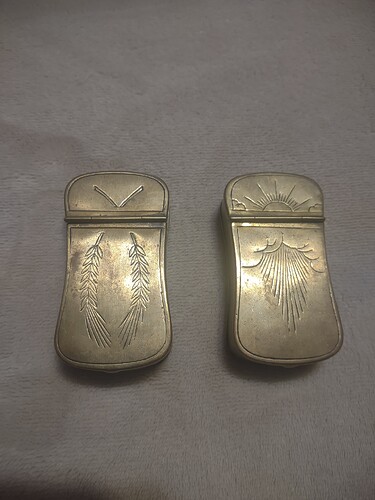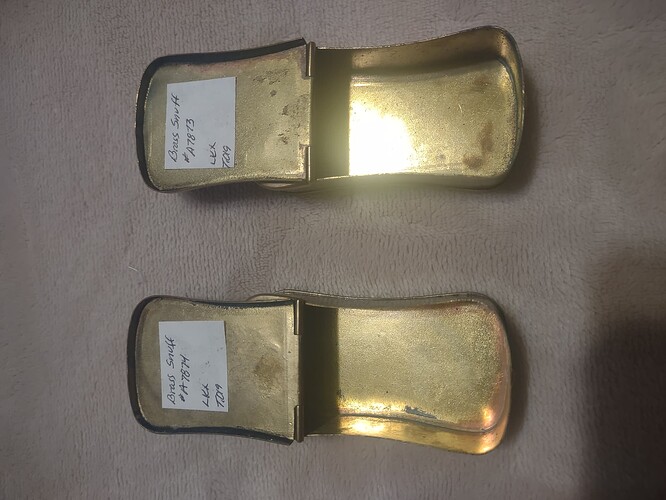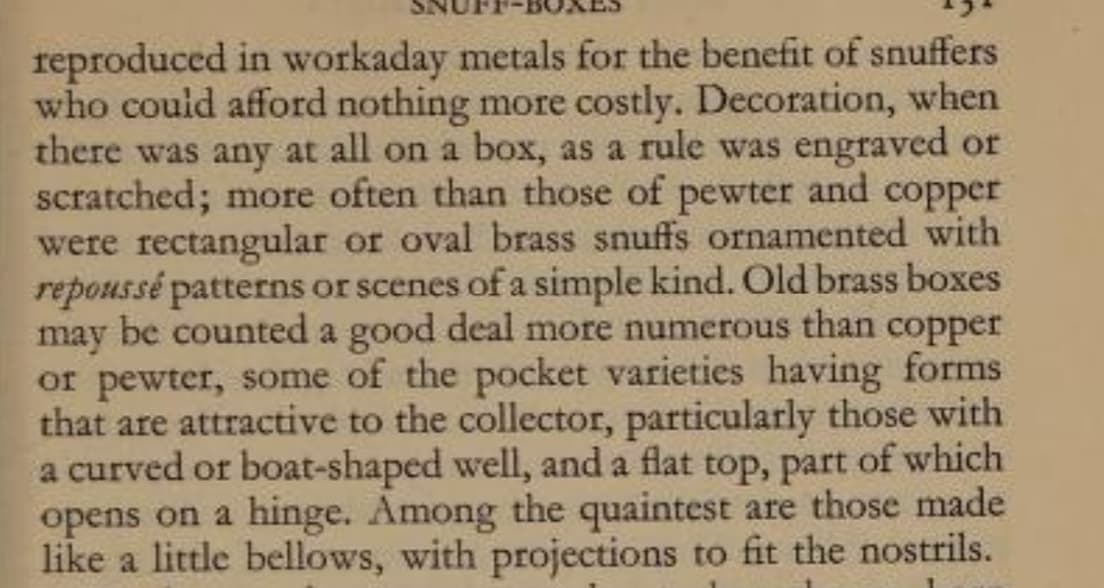Hi guys, picked these up and I was wondering if anyone knows something about them. The date etc. They are nice and in a good condition.
Very nice snuff boxes
There is no reference of scale in your pictures. However, they are almost certainly snuff/tobacco boxes once belonging to a miner. Brass was by far the most common material used for snuff/tobacco boxes in the mining industry.
As for age they could have been made anywhere between the 1800s and early 1900s.
Where did you acquire them?
Yes, those are snuff boxes. I’m taking a guess here but suggest that they were made in Britain or Europe. Why? Because they are likely 19th century, a time when chewing quids/plugs followed by noisome expectorating was widespread in the USA rather than snuff-taking which was so common in the mining industry throughout the British Isles.
Unfortunately that doesn’t help you much, I’m afraid. Suffice to say that they were, in my estimation, more likely made outside the USA rather than in the USA, or if American, hail from a state with a mining history.
Snuff and Snuff-Boxes by Hugh McCausland might provide more answers. A member who has a copy of that 1951 book might elucidate further, but I’d wager that they are miner boxes.
Thank you for taking the time reply. I wish I could find out a bit more information about them, but they’re cool nevertheless.
My pleasure.
Because of a lack of assay marks on metal (except gold and silver) it is impossible to say with certainty where and when they were made – beyond my guess of 19th century British manufacture. For years Professor Allen Phillips Griffith (together with those he enlisted to help) attempted to discover the origin of the snuff-boxes he bought from a market in Holland without success.
However, they are indeed very nice boxes and you must be proud to possess little pieces of snuff/industrial history from a bygone age. Well done.
Bye the bye, these are the boxes belonging to the late Griff. They’re unlikely to ring any bells after all this time ….but one never knows.

They are some nice snuff boxes. I think I remember him posting on this site or maybe another. It’s a shame he never got to the origin of the boxes.
Yeah they are cool and I’ll keep them, maybe even use them.
Thanks for the reply and posting that. Really cool.
I did a little digging and based on the shape, and hinge design it may be circa 1800.
In any case, they are definitely not unique, because I found an identical one, but sold as a match container. However, this would suggest that we are dealing with a factory product.
So then would it still be circa 1800?
That’s even more cool if they are that old.
Thanks guys.
I saw similar hinge designs online circa 1800, but I’m not sure how long that hinge design was used. Could be circa 1800 or later.
Oftentimes people selling vintage items will just slap on a date to make it old. “matchbox from the 1940’s” could actually be from the 70s lol. It all depends
Yeah I understand that.
You can find many stylistically similar snuff boxes on the Internet. Some of them even have the year engraved on them, so you could even say that yours could date from around 1880-1910. However, this is just speculation. Unfortunately, there is no trademark, so it’s really hard to find any point of contact to discover the real manufacturer.
However, I remember once I was asked to find some information about a Swedish snuff box that one of the Polish snufftakers had - also without a trademark. I found a similar one with the correct trademark, which belonged to a well-known Swedish company. But there were also valuable informations that the snuff boxes that were unmarked were intended to imitate those of well-known companies. I suspect that the brass ones have might also have their equivalent in a better quality material.
Thanks everyone for the replies. I was wondering if I should use them or not. I’ll probably just keep them as collectibles…maybe.
@PhilipS2, So proffesor’s snuff boxes did not have a trademark of any kind on them?
Edit: Anyways I’ve found the same snuff boxes with the signature of silvermaker de Leeuv den Bouter.
I’m still trying my best at uncovering the secret of Griff’s second snuffbox. I found the same one in one of the Polish collections. Unfortunately, there is no close-up of the marks.
If anyone is interested, the scene depicted on the snuff box is the painting After Work in the Country (1659) by Adriaen van Ostade.
Some time ago I wrote to the collector who has this snuff box to get a better look at the hallmarks, but unfortunately I did not receive a reply. What a pity… Although I already know that the snuff box is not Dutch but Danish (even though in both cases it was purchased in the Netherlands). It was made by Hans Jensen, who (looking at his other works) really liked the work of Adriaen van Ostade.
It is true that the professor did not live to see the solution to the mystery, but I’m still glad I could solve it on the 10th anniversary of his death. A big pinch of snuff for you Griff!






